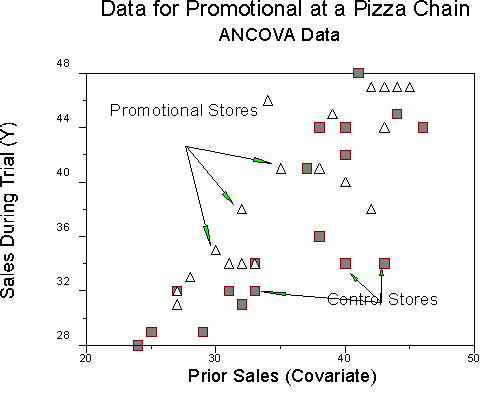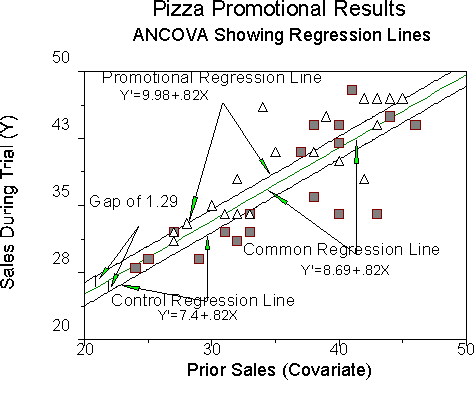Thank you for visiting our site! You landed on this page because you entered a search term similar to this: least common multiple using the ladder method.We have an extensive database of resources on least common multiple using the ladder method. Below is one of them. If you need further help, please take a look at our software "Algebrator", a software program that can solve any algebra problem you enter!
Store | Pre sales (X) | Trial sales (Y) | Group (G) | Store | Pre sales (X) | Trial sales (Y) | Group (G) |
1 | 30 | 35 | 1 | 21 | 33 | 32 | -1 |
2 | 28 | 33 | 1 | 22 | 27 | 32 | -1 |
3 | 40 | 40 | 1 | 23 | 38 | 36 | -1 |
4 | 33 | 34 | 1 | 24 | 33 | 34 | -1 |
5 | 45 | 47 | 1 | 25 | 46 | 44 | -1 |
6 | 43 | 44 | 1 | 26 | 40 | 44 | -1 |
7 | 32 | 34 | 1 | 27 | 31 | 32 | -1 |
8 | 38 | 41 | 1 | 28 | 37 | 41 | -1 |
9 | 42 | 47 | 1 | 29 | 44 | 45 | -1 |
10 | 27 | 31 | 1 | 30 | 25 | 29 | -1 |
11 | 31 | 34 | 1 | 31 | 32 | 31 | -1 |
12 | 27 | 31 | 1 | 32 | 29 | 29 | -1 |
13 | 42 | 38 | 1 | 33 | 40 | 34 | -1 |
14 | 35 | 41 | 1 | 34 | 43 | 34 | -1 |
15 | 44 | 47 | 1 | 35 | 41 | 48 | -1 |
16 | 39 | 45 | 1 | 36 | 40 | 42 | -1 |
17 | 32 | 38 | 1 | 37 | 33 | 32 | -1 |
18 | 34 | 46 | 1 | 38 | 38 | 44 | -1 |
19 | 43 | 47 | 1 | 39 | 40 | 44 | -1 |
20 | 27 | 32 | 1 | 40 | 24 | 28 | -1 |
Note that we have 20 stores in each of two groups (Promo = 1; Control = -1) for a total of 40 stores. Let's take a peek at the data.

We want to know if the promotional has an effect on sales. From SAS PROC MEANS, we find that:
| Dependent Variable | Covariate | ||
Group | Mean | SD | Mean | SD |
Promo | 39.25 | 5.98 | 35.60 | 6.30 |
Control | 36.75 | 6.46 | 35.70 | 6.38 |
On the covariate (right columns), we find that the means and SDs are similar for both groups. On the dependent variable (left columns), the mean of sales is about 2.5 points higher for the promotional group than for the control group. Will this be a significant difference? ANOVA "decides" whether a difference is significant by looking at the mean difference in light of the SD and the sample size, N. In this problem, our mean difference is a little less that 1/2 standard deviation.
Well, we can do simple ANOVA without the covariate (that is, Y = a + b1G). If we do, we find that the model has 1 df, with a sum of squares of 62.50, the error term has 38 df, with a sum of squares of 1473.5. Our F is 1.61, which is not significant (p = .21), and R2 is .04.
But we know that lots of the variance in Y is due to location, management and labor effects. We can use prior sales to adjust or control for this. We start ANCOVA by looking for the interaction between the treatment and covariate. If we use PROC REG, we get the following results:
Model: | F=29.78 | p < 1 | R2 =.71 |
|
|
Variable | DF | Par Est | SE | T | P |
Intercept | 1 | 8.69 | 3.24 | 2.68 | .01 |
G | 1 | 1.13 | 3.24 | .35 | .73 |
X | 1 | .82 | .09 | 9.18 | .01* |
GX | 1 | 4 | .09 | .05 | .96 |
As you can see, the model is significant and has a substantial R2. The interaction term is not significant, so we can drop that term and revise our estimates, thus:
Model: | F=45.90 | p < 1 | R2 =.71 |
|
|
Variable | DF | Par Est | SE | T | P |
Intercept | 1 | 8.69 | 3.20 | 2.72 | .01* |
G | 1 | 1.29 | .55 | 2.37 | .02* |
X | 1 | .82 | .09 | 9.30 | 1* |
Note that both terms are significant. This means that the promotional has an effect that can be detected after removing the variance due to pre-existing differences in sales among stores within cells. The resulting regression model is one with two parallel lines - identical slopes but different intercepts.
I use PROC GLM rather than PROC REG for this kind of analysis. See the SAS lab manual for a description.
Recap: Our ANCOVA results thus far indicate that there is an effect of the promotional on sales. We can compute the regression lines for the two groups from the results of the REG procedure. Our equation:
Y' = 8.69+1.29G + .82X
We are using the common regression coefficient, bc, which in this case is .82. The b for the group factor modifies the global intercept. For the promotional group, the value of G is 1, so for that group,
apromo = 8.69+1.29 = 9.98, so for this group, the regression line is Y' = 9.98+.82X
For the control group, the value of G is -1, so for that group,
acontrol = 8.69-1.29 = 7.4, so for this group, the regression line is Y' = 7.4+.82X.

Recall that our regression from ANCOVA was Y' = 8.69+1.29G+.82X. Note that the slope for all three regression lines is .82. Note that the intercept of the common line is 8.69, which is the value of a. Note that the gap between each group and the common line is 1.29, which is the value of b for the G term.
Adjusted Means
When analysis of covariance is appropriate, we can adjust the means of the groups on Y for differences in X.
[Technical note: ANCOVA is appropriate when in addition to the ordinary assumptions of regression (approximate normality, homoscedasticity, linearity), we also have
- the appropriateness of the common regression coefficient bc assumption firmly supported by the data (bc is the slope in the model with G and X but not GX in it; the test for GX supports the common slope bc ) and
- bc is also large enough to make a difference (R2 increases by about .10 by including the covariate over the model with the treatment only-- the correlation between X and Y needs to be about .30 for the covariate to do much for you. In our promotional example, r = .82.]
Back to adjusting means. The adjustment is:

where ![]() is the adjusted mean of Group J on the DV,
is the adjusted mean of Group J on the DV, ![]() is the mean of Group J on the DV, b is bc, the common slope,
is the mean of Group J on the DV, b is bc, the common slope, ![]() is the mean of Group J on the covariate, and
is the mean of Group J on the covariate, and ![]() is the grand mean of the covariate, that is, the mean on the covariate over all groups. Note that the formula for adjustment is just like the formula for predicting raw values (not means) in deviation score form, that is,
is the grand mean of the covariate, that is, the mean on the covariate over all groups. Note that the formula for adjustment is just like the formula for predicting raw values (not means) in deviation score form, that is,

In our example, the data are
| X | Y |
Grand Mean | 35.65 | 38 |
Promo Mean | 35.6 | 39.25 |
Control Mean | 35.7 | 36.75 |
The adjusted means are
For the promotion group:
![]() =39.25-.82(35.6-35.65) = 39.291.
=39.25-.82(35.6-35.65) = 39.291.
For the control group:
![]() = 36.75-.82(35.7-35.65) = 36.709.
= 36.75-.82(35.7-35.65) = 36.709.
Note that the adjusted means are slightly farther apart than the raw means; the promo group's mean is raised slightly and the control mean is lowered slightly. The reason for the adjustment is that the control group started out slightly richer, with better locations and/or more talented people than did the promotional group. ANCOVA can adjust for this difference. If we had done the instructional study in research methods, and found that at the start one group was smarter than the other was, we make an analogous adjustment for cognitive ability. Note that in both cases we randomly assigned people to treatments, so we expect minor adjustments only.
We can test for the differences among the adjusted means, too. There are some really ugly formulas to compute F for the difference. But we won't be using them because it turns out that testing for the difference between adjusted means is tantamount to (my favorite Pedhazur phrase) testing the difference between intercepts of regression lines that share a common slope. Testing for the difference between intercepts turns out to be the same as testing for the difference in b weights for the coded vectors that represent group membership. You remember that the b weight(s) for the G variable adjust the grand intercept up or down for each group, so the b weights amount to differences in intercepts. We can test for the significance of the difference between b weights in the same equation using a method we discussed early on. This method rests on the sampling covariance matrix of the b weights.
Fortunately for us, SAS will do this for us. In our example, I used the code:
Code | Meaning |
proc glm; | Invoke the general linear models procedure |
class g; | Variable G is categorical |
model y = g x; | Regression model for ANCOVA |
lsmeans g/ pdiff; | Give me least squares means (adjusted means) for variable G and test for their difference returning the probability for H0 that the means are equal. |